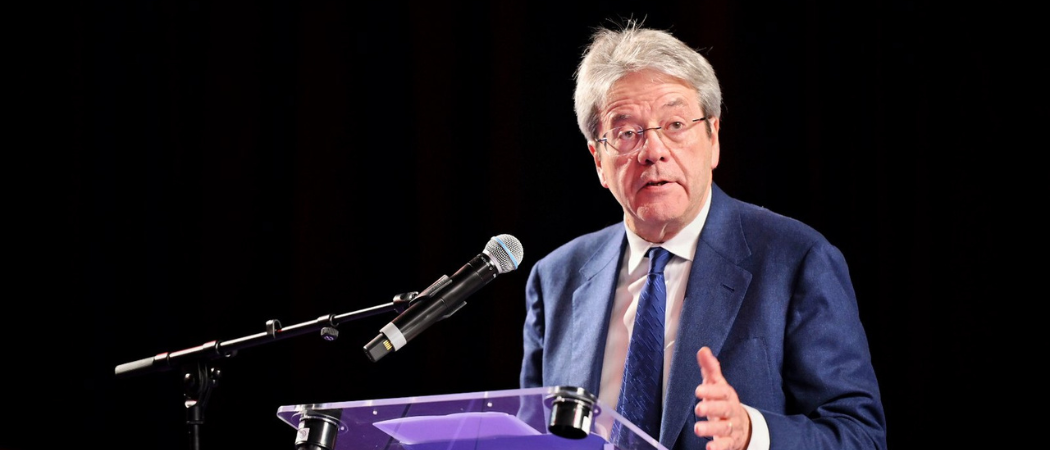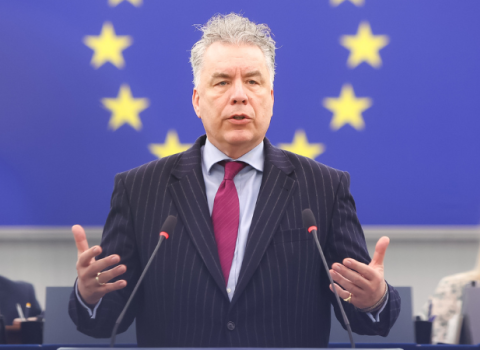Paolo Gentiloni throws down a radical suggestion for the next Commission to solve Europe’s R&D underinvestment problem. But any extension of joint financing would be controversial

Paolo Gentiloni, European commissioner for economy, at the R&I Days on Wednesday. Photo credits: European Innovation Council team / European Union
The EU should extend its unprecedented post-pandemic common borrowing spree to fund research and innovation and prevent the bloc falling even further behind on R&D spending, economy commissioner Paolo Gentiloni has argued.
Speaking at the European Commission’s annual research and innovation conference, Gentiloni painted a bleak picture of the EU’s prospects – and said only collective action, like joint debt-financed spending, could solve the problem.
“Common tools to finance our common goals and to finance research and innovation are fundamental if we want to remain the Europe that we are,” he told delegates at the R&I Days in Brussels on 20 March.
Following the economic shock of the pandemic, in 2021 the EU took the largely unprecedented step of jointly borrowing around €800 billion to fund recovery projects in member states. The Commission went from borrowing around €400 million a year pre-pandemic to raising €124 billion in 2021, Gentiloni noted.
But this programme of spending, NextGenerationEU, will expire in 2026. “Which is tomorrow. What happens next?” he asked.
Gentiloni suggested a new “NextGenerationEU type instrument for research and innovation”, or a “sector specific tax credit managed at EU level” to boost R&D.
Any extension of joint borrowing, which was always sold as a temporary response to the pandemic, would be likely to face tough opposition from traditionally frugal member states. The Netherlands has repeatedly come out against any new facility.
But Gentiloni pointed to “very weak” EU economic growth of 0.4% last year, and “lacklustre” performance in productivity, and said an increase in research and innovation spending was essential.
EU R&D spending as a proportion of the economy has crept up to 2.2%, but at this rate of increase would not hit its 3% target by 2030.
Even if the EU hit that milestone, it would still lag behind the investment levels of the US at 3.5%, Japan 3.4%, or South Korea at 4.8%.
“In this context of weaker growth, and mounting geopolitical tensions, there are concerns that Europe may keep losing ground to the other global players,” Gentiloni said.
European green industries, for example, have repeatedly warned that they are being squeezed out of business or induced to relocate by much bigger subsidies in the US and China.
One answer to low EU R&D spending is for member states to spend more themselves.
But Gentiloni believes relying on member states will only widen the European research and innovation gap.
“Several countries in western and northern Europe are as productive and innovative, or even more so, than for example, the US. But on the other hand, eight member states spent less than 1% of GDP in R&D,” he told delegates.
Hence common EU tools are needed. “This is an area where if we leave it only to the single member states, it might even increase divergences within the EU […] between those with deeper pockets and those who do not have the same fiscal space to finance innovation, so we need European solutions,” he said.
Of course, Gentiloni’s radical plan is not something he can enact – it is more a gauntlet thrown down for the next Commission, which will be appointed after European elections in June.
“We are a Commission at the semi-final period of its activity,” he said.





 A unique international forum for public research organisations and companies to connect their external engagement with strategic interests around their R&D system.
A unique international forum for public research organisations and companies to connect their external engagement with strategic interests around their R&D system.